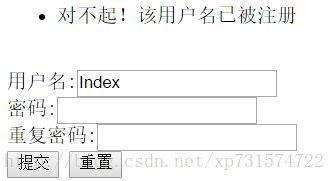Struts 2+Hibernate实现完整登录注册(带验证)
Struts 2+Hibernate实现完整登录注册
环境
MyEclipse 2014
数据库:SQL sever 2016
Tomcat:apache-tomcat-8.0.46
JDK:1.6
Sturts版本:2.1
Hibernate版本:4.1
前期准备
创建项目以后,为项目添加
Sturts和Hibernate能力连接数据库并生成POJO类:Hibernate框架连接SQL sever 2016完整详细步骤
还有一个一定会出错的地方,因为Hibernate和Struts 2 中有相同的包(版本不同)会引起冲突,所以要把Struts 2 中的
antlr-2.7.2.jar移除,具体操作可以看这篇:java.lang.NoSuchMethodError: antlr.collections.AST.getLine()I最终解决方案
登录功能
1.先编写对数据库进行操作的DAO类UserInfoDao.java
public class UserInfoDao {
private Session session;
private Transaction t;
public void getCurrentSession(){
session=HibernateSessionFactory.getSession();
}
public void closeSession(){
if(session!=null){
HibernateSessionFactory.closeSession();
}
}
/**
* 登录函数:验证用户名和密码
* @param vo
* @return true 存在
* @return false 不存在
*/
public boolean loginByUserInfo(UserInfo vo){
getCurrentSession();
t=session.beginTransaction();
String userAccount = vo.getUserAccount();
String userPassword = vo.getUserPassword();
Query query = session.createQuery("from UserInfo where userAccount='"+userAccount+"' and userPassword='"+userPassword+"'");
List list=query.list();
closeSession();
if(list!=null)
return true;
return false;
}
}2.LoginAction.java
package org.action;
import java.util.Map;
import org.dao.UserInfoDao;
import org.vo.UserInfo;
import com.opensymphony.xwork2.ActionContext;
import com.opensymphony.xwork2.ActionSupport;
public class LoginAction extends ActionSupport{
private UserInfo userInfo;
private String message; //用于显示验证错误信息
/**
* 处理用户请求的 execute 方法
* 因为此函数在 validate()后执行,所以可以保证用户名和密码正确
* @return SUCCESS
*/
public String execute() throws Exception{
Map session = ActionContext.getContext().getSession();
session.put("userInfo", userInfo);
return SUCCESS;
}
/**
* 验证用户名和密码
* 先判断是否为空,再验证
*/
public void validate(){
if(userInfo.getUserAccount()==null || userInfo.getUserAccount().equals(""))
this.addFieldError("userAccount", "用户名不能为空");
else if(userInfo.getUserPassword()==null || userInfo.getUserPassword().equals(""))
this.addFieldError("userPassword", "密码不能为空");
else {
UserInfoDao dao = new UserInfoDao();
if(dao.loginByUserInfo(userInfo)==false)
this.addFieldError("userAccount", "用户名或密码错误");
}
}
//自动生成的getter和setter
public UserInfo getUserInfo() {
return userInfo;
}
public void setUserInfo(UserInfo userInfo) {
this.userInfo = userInfo;
}
public String getMessage() {
return message;
}
public void setMessage(String message) {
this.message = message;
}
}
3.登录界面login.jsp
<%@ page language="java" import="java.util.*" pageEncoding="utf-8"%>
<%@taglib prefix="s" uri="/struts-tags" %>
<html>
<head>
<title>login.jsptitle>
head>
<body>
<s:form action="loginAction" method="post" theme="simple">
<s:fielderror><s:property value="message"/>s:fielderror><br>
用户名:<s:textfield name="userInfo.userAccount"/><br>
密码:<s:password name="userInfo.userPassword"/><br>
<s:submit value="登录"/><s:reset value="重置"/>
s:form>
body>
html>
登录成功界面success.jsp:
<%@ page language="java" import="java.util.*" pageEncoding="utf-8"%>
<%@taglib prefix="s" uri="/struts-tags" %>
<html>
<head>
<title>success.jsptitle>
head>
<body>
<s:set name="userInfo" value="#session['userInfo']"/>
<s:property value="#userInfo.userAccount"/>,你好!
body>
html>4.修改struts.xml文件
<struts>
<package name="default" extends="struts-default">
<action name="loginAction" class="org.action.LoginAction">
<result name="success">/success.jspresult>
<result name="input">/login.jspresult>
action>
package>
struts> 访问http://localhost:8080/Ex5/login.jsp,可以判断输入是否合法,且可以验证用户名和密码,并在上面给出错误信息
注册功能
1.在UserInfoDao.java中添加实现注册的函数
package org.dao;
import java.util.List;
import org.hibernate.Query;
import org.hibernate.Session;
import org.hibernate.Transaction;
import org.util.HibernateSessionFactory;
import org.vo.UserInfo;
public class UserInfoDao {
private Session session;
private Transaction t;
public void getCurrentSession(){
session=HibernateSessionFactory.getSession();
}
public void closeSession(){
if(session!=null){
HibernateSessionFactory.closeSession();
}
}
/**
* 登录函数:验证用户名和密码
* @param vo
* @return true 存在
* @return false 不存在
*/
public boolean loginByUserInfo(UserInfo vo){
getCurrentSession();
t=session.beginTransaction();
String userAccount = vo.getUserAccount();
String userPassword = vo.getUserPassword();
Query query = session.createQuery("from UserInfo where userAccount='"+userAccount+"' and userPassword='"+userPassword+"'");
List list=query.list();
closeSession();
if(list!=null)
return true;
return false;
}
/**
* 注册函数:先查询表中是否已经存在相同的用户名,再进行插入操作
* @param vo
* @return true 注册成功
* @return false 注册失败
*/
public boolean registerByUserInfo(UserInfo vo){
getCurrentSession();
t=session.beginTransaction();
String userAccount = vo.getUserAccount();
Query query = session.createQuery("from UserInfo where userAccount='"+userAccount+"'");
List list = query.list();
if(list.size()>0){//如果表中已经有相同的用户名
closeSession();
return false;
}else{
session.save(vo);
t.commit();
closeSession();
return true;
}
}
}2.RegisterAction.java实现判断输入是否合法以及数据库中是否已存在相同的用户名
package org.action;
import java.util.Map;
import org.dao.UserInfoDao;
import org.vo.UserInfo;
import com.opensymphony.xwork2.ActionContext;
import com.opensymphony.xwork2.ActionSupport;
public class RegisterAction extends ActionSupport{
private String userAccount;
private String userPassword;
private String rePassword;
private String message; //用于显示验证错误信息
/**
* 处理用户请求的 execute 方法
* 因为此函数在 validate()后执行,所以可以保证用户名和密码正确
* @return SUCCESS
*/
public String execute() throws Exception{
Map session = ActionContext.getContext().getSession();
UserInfo vo = new UserInfo();
vo.setUserAccount(userAccount);
vo.setUserPassword(userPassword);
session.put("userInfo", vo);
return SUCCESS;
}
/**
* 先验证用户名和密码是否为空
* 再验证进行插入操作
*/
public void validate(){
if(userAccount==null||userAccount.equals("")){
this.addFieldError("userAccount", "用户名不能为空");
}else if(userPassword==null||userPassword.equals("")){
this.addFieldError("userPassword", "密码不能为空");
}else if(userPassword.equals(rePassword)==false){
this.addFieldError("rePassword", "两次密码必须一致");
}else{
UserInfoDao dao = new UserInfoDao();
UserInfo vo = new UserInfo();
vo.setUserAccount(userAccount);
vo.setUserPassword(userPassword);
if(dao.registerByUserInfo(vo)==false){
this.addFieldError("userAccount", "对不起!该用户名已被注册");
}
}
}
//自动生成的getter和setter
public String getUserAccount() {
return userAccount;
}
public void setUserAccount(String userAccount) {
this.userAccount = userAccount;
}
public String getUserPassword() {
return userPassword;
}
public void setUserPassword(String userPassword) {
this.userPassword = userPassword;
}
public String getRePassword() {
return rePassword;
}
public void setRePassword(String rePassword) {
this.rePassword = rePassword;
}
public String getMessage() {
return message;
}
public void setMessage(String message) {
this.message = message;
}
} 3.注册界面register.java
<%@ page language="java" import="java.util.*" pageEncoding="utf-8"%>
<%@taglib prefix="s" uri="/struts-tags" %>
<html>
<head>
<title>register.jsptitle>
head>
<body>
<s:form action="registerAction" method="post" theme="simple">
<s:fielderror><s:property value="message"/>s:fielderror><br>
用户名:<s:textfield name="userAccount" /><br>
密码:<s:password name="userPassword" /><br>
重复密码:<s:password name="rePassword"/><br>
<s:submit value="提交"/><s:reset value="重置"/>
s:form>
body>
html>4.在struts.xml文件中添加用户注册的action配置
<struts>
<package name="default" extends="struts-default">
<action name="loginAction" class="org.action.LoginAction">
<result name="success">/success.jspresult>
<result name="input">/login.jspresult>
action>
<action name="registerAction" class="org.action.RegisterAction">
<result name="success">/success.jspresult>
<result name="input">/register.jspresult>
action>
package>
struts> 访问http://localhost:8080/Ex5/register.jsp即可实现注册
其他:
最终的struts.xml
<web-app xmlns:xsi="http://www.w3.org/2001/XMLSchema-instance" xmlns="http://java.sun.com/xml/ns/javaee" xsi:schemaLocation="http://java.sun.com/xml/ns/javaee http://java.sun.com/xml/ns/javaee/web-app_3_0.xsd" version="3.0">
<display-name>Ex5display-name>
<filter>
<filter-name>struts2filter-name>
<filter-class>org.apache.struts2.dispatcher.ng.filter.StrutsPrepareAndExecuteFilterfilter-class>
filter>
<filter-mapping>
<filter-name>struts2filter-name>
<url-pattern>/*url-pattern>
filter-mapping>
web-app>


